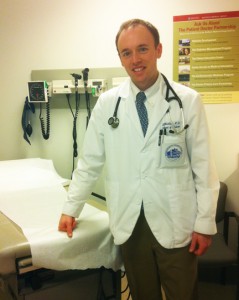
Brad Wertheim ’07
Too much iron—is that possible? Yes, for people who have a gene resulting from an ancient DNA mutation that causes iron to accumulate to toxic levels in their organs.
When Dr. Brad Wertheim ’07 learned about “the Celtic curse” of hereditary hemochomatosis during medical school, he wondered why it had a predilection for those of Irish heritage.
“I began reading, and saw there was a story to tell,” he says. Indeed, his curiosity led to the publication of an in-depth and fascinating article, “The Iron in Our Blood That Keeps and Kills Us,” in The Atlantic (January 2013). “The biochemical properties of iron and events in ancient Europe probably explain who and why so many are afflicted with this disease.”
An internal medicine resident at Massachusetts General Hospital, Boston, Wertheim has always been interested in science and in history, particularly its relationship with human biology.
“Biology influences history, and vice versa,” he says. “And when you dig down far enough, you begin to see other connections between science and seemingly unrelated disciplines. Courses with Bryan Washington, Owen McLeod, Donald Miller, and David Johnson supplemented my science and math courses, and further stimulated my interest in the humanities.”
Wertheim uses an interesting and colorful style to spin a tale that begins with the death of one of the world’s most important geneticists—Dr. Malcolm Casadaban—and includes the Black Death to unknown ancestors who lived millennia ago, gene research, Viking traders, and the rise of agriculture. He writes, “As elements go, iron is a fickle and mischievous companion. Essential to life, yet impulsive, promiscuous, and destructive when allowed to roam unescorted, it poses a tremendous engineering challenge to human tissues.”
The gene that causes the accumulation of iron, abbreviated as C282Y by biochemists, shows up most often in people of Northern European descent.
“As an advantageous allele spreads through a population, the surrounding neighborhood of nearby genes ‘hitchhike’ along and loyally follow the selected variant from generation to generation, like an entourage around a celebrity,” he writes. “Maybe C282Y is simply one of the hangers-on, a groupie following a future guitar god of the human genome: an allele with undiscovered virtuosity, currently soloing in obscurity in Mom’s garage.”
A biochemistry graduate, Wertheim holds an M.D. from Harvard. He has been interested in medicine since childhood and found many opportunities to explore the field prior to medical school—shadowing opportunities and conversations with physicians and other health care providers, work as a volunteer EMT, and mentorship and research opportunities with Laurie Caslake and Yvonne Gindt at Lafayette.
“These research experiences taught me a structured approach to problem solving that I employ almost every day,” he says. “Make an intervention, measure its effect on a given outcome, and adjust your intervention to produce a desired effect. We use it not just in lab but in our daily practice; for example, to adjust ventilator settings or tailor response to medications.”
Although Wertheim anticipated a demanding lifestyle, he has been surprised by having only four days off a month.
“Clinically, I continue to be saddened, amazed, and frustrated by how so much of our health care consumption—and costs—are fueled by substance abuse and medical conditions precipitated by mental health problems,” he says.
He also notes that the practice of medicine has been transformed from an individual to a team activity.
“Gone are the days of the classic general practitioner who can deliver babies, manage heart failure, and take out an appendix,” he says. “Medicine has so many moving parts. You learn just as much from your colleagues as you do from any book. The best part of my job is the gratitude after a job well done, but a close second is the opportunity to collaborate with such a talented and exciting group of physicians.”
He adds, “Every day, I have to apply my training in science and healing in a different way—no two patients are the same. Writing gives me the venue to reflect on this experience and explore the origin and progress of medicine. I am thankful for the opportunity.”
